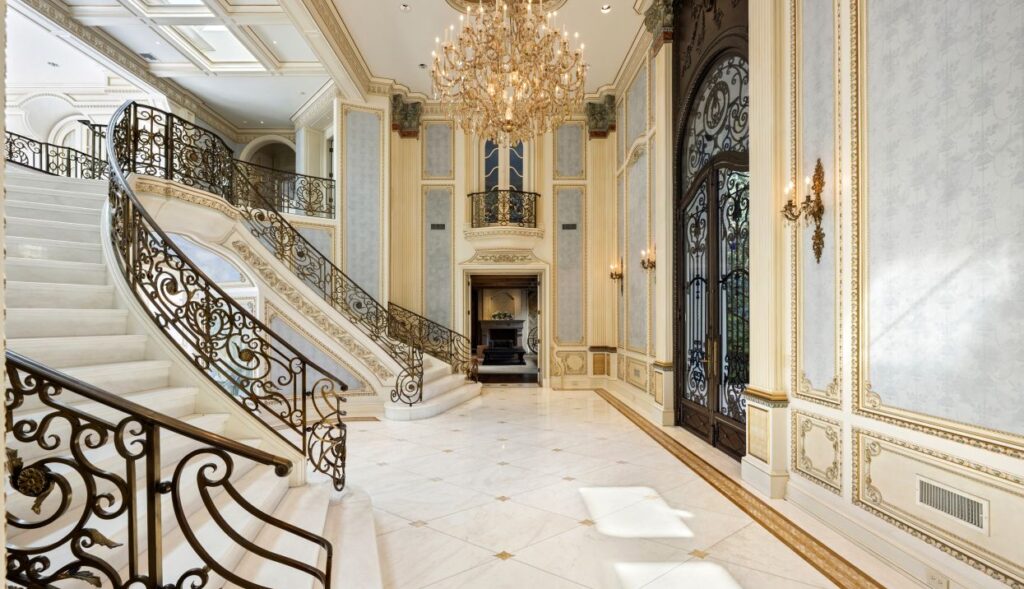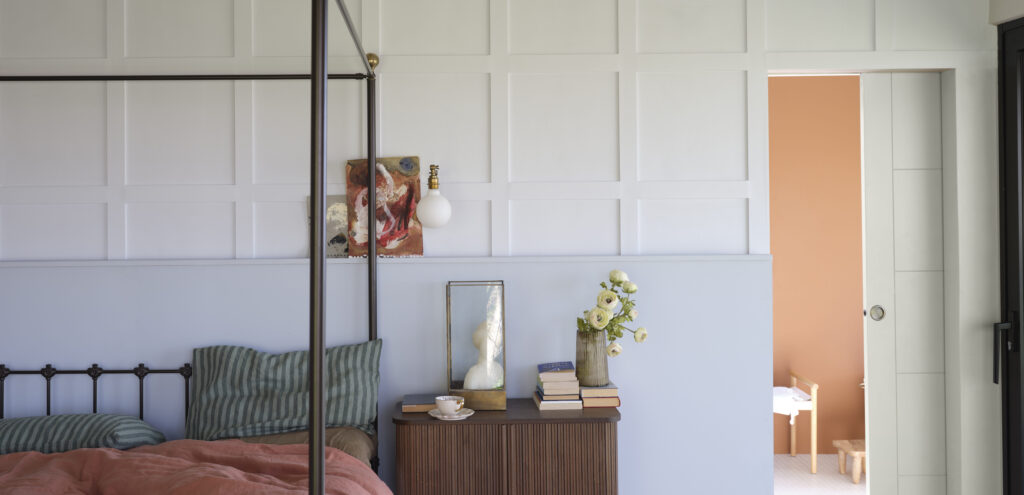The first thing that comes to mind when stepping into Stanley Casselman’s studio at Mana Contemporary is, “How does an economics major from Pitzer College in California end up creating beautiful abstract paintings in Jersey City?” After a brief look around, it’s clear. Stanley Casselman was born to create.
Casselman became well-known in the art world after answering Art Critic Jerry Saltz’s social media challenge for an imitation Gerhard Richter painting. For Casselman, true art is creating something new and original. So much so that even his initial imitations of Richter became uniquely his own. Using a 10-foot homemade squeegee, he put his own impressionistic-like spin on Richter, leading to projects such as “Inhaling Richter” and “Luminor.”
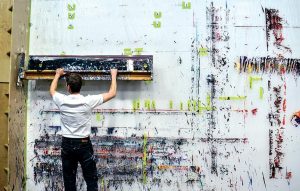 Today, Casselman is part of Mana Contemporary, a growing cultural center of over 1 million square feet. He has since shifted his focus to work on polyester screen (silkscreen) in what he calls “Frequency.” Though he still uses some similar practices from previous works, Casselman now creates his “Frequency” works from behind the actual painting, applying and forcing paint through with huge squeegees. In his latest abstractions, Casselman searches for moments and emotions in their most natural form, capturing them in the layered complexity of the polyester screen.
Today, Casselman is part of Mana Contemporary, a growing cultural center of over 1 million square feet. He has since shifted his focus to work on polyester screen (silkscreen) in what he calls “Frequency.” Though he still uses some similar practices from previous works, Casselman now creates his “Frequency” works from behind the actual painting, applying and forcing paint through with huge squeegees. In his latest abstractions, Casselman searches for moments and emotions in their most natural form, capturing them in the layered complexity of the polyester screen.
The scope of Mana Contemporary is massive. What brought you here?
I was in Fort Greene, Brooklyn at the end of a seven year lease. The neighborhood had gone from kind of shitty but safe, which means it was reasonably priced, to new condo construction everywhere. I was adjacent to Pratt. My landlord said my rent was going up significantly and that he wanted a 90-day out. Definitely an “oh shit” moment. So I started looking in Bushwick, Sunset Park, and Long Island City, even the Bronx, and I wasn’t thrilled with what I was finding. At the time, the Eyelene Kaminski Foundation was opening at Mana. So one Sunday, my wife and kid were doing something else and I thought what the hell, I’ve heard her name, I’ll go and hobnob and try to sell her a painting. I walked in, got on the freight elevator, which is huge, and that’s a thing that often limits a building is that the freight elevator is too small. But I saw this one and I got excited, walked onto the fourth floor, saw the ceiling height, the space, the light and I spent the rest of the time finding out who I had to talk to to get a studio. At the time, there were only seven studios. So I found Micha Lang [founder] and here I am. The carrot they dangled back then, is that one day there’s gonna be a cafe on the fourth floor and I thought, “Bullshit. It’ll never happen.” Well, lo and behold there’s a cafe now, there’s five public exhibition spaces, one of which is 50,000 square feet, it’s incredible what they’ve done. It’s turned into this amazing thing.
How has Mana impacted the local culture?
What I’ve seen in the years I’ve been here is a lot of high rises and apartments go up. It’s clearly impacting the area. It’s pretty extraordinary. It’s turned into a true community. I was in an artist loft complex in Los Angeles called the Brewery, the old Pabst Brewery, and there were 320 studios larger than this, it was a huge complex. But nobody tried to make it something. You had a landlord whose number one concern was money, and just wanted you to pay. Period. I respect that, but no idea how to make it a community, to get important people there, it could’ve really become something. I had some good friends there, but what they’re doing here, this is a destination. A destination for curators, for dealers, for people who want to see art, people who want to buy art. I didn’t expect that. I came here for the space and the light. It’s funny because when I saw the studio that Sunday I told my wife, and she said to me, I think this is a direct quote, “Are you out of your fucking mind? You can’t get people to your studio in Brooklyn, how on earth do you think you’ll get them to Jersey City?” And I had no idea, I was just freaked out about having to drive through a tunnel. I mean what if there’s a leak? You’re fucked. [Laughs.] But whatever, it was the smartest thing I ever did. One of my dealers, Scott White, I have only because I was in this studio.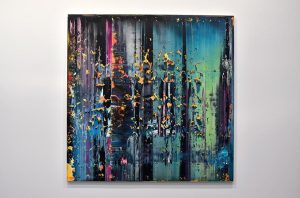
Do you experience a lot of ups and downs in your career?
Of course. My early success was fits and starts; no good galleries behind what I was doing, maybe some that were OK, some that ripped me off. You know, every typical artist story. The [Jerry] Saltz thing and making the work derivative of Richter really changed the landscape. When I started making that work, and it started selling, it was more fuel to the fire. The one thing that work gave me was a PhD in color. In the course of making this type of work, more [paint] would come off than would actually stay on. I didn’t care if I just scraped off $500 dollars worth of paint. And my success ratio with those paintings was probably one out of three. I’m not interested in having an average painting out there. Even if it’s sellable. So what? What I want out there, is stuff that sings. The world doesn’t need another mediocre painting.
With all the work you’ve created, especially in the last few years, how do you characterize success?
It’s when a painting makes the hairs on the back of my neck stand up. If I’m lucky, I get that once a year.
You live for those moments.
Yeah. That’s success. Money is great and wonderful, and if I have a big ton of it I’d set up a foundation to give money away to artists. On the other hand, without money I can’t have a studio this size and make paintings. It’s expensive to do this stuff, I’ve got assistants. The money side of it is not the least of it all but it’s not important. It’s about the work. It’s about creating things that have never been made before.
How did you shift from making work derivative of Richter to “Frequency”?
The paintings that I was making prior to the work derivative of Richter was acrylic on silkscreen fabric. I call it polyester screen which is actually what it is. But it’s not printed, it’s painted with a squeegee. I decided to shift gears when I really felt as though I wasn’t discovering things on a rather continual basis. And it wasn’t new, it wasn’t fresh. I mean it’s sellable all day long, but I was going through the motions. About December 2015 I decided to switch gears and so I started dabbling back into painting on a polyester screen. I noticed this effect/frequency three years ago and I thought it was interesting but I want to have a reason to use it. And finally, in these paintings, there’s a reason. It has this effect of adding this energy to the piece.
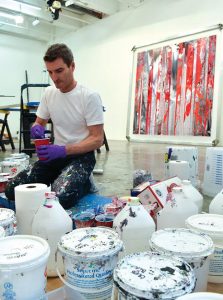 How did you come up with the title for “Frequency”?
How did you come up with the title for “Frequency”?
The term “frequency” is speaking to the frequencies of light. Painting itself boils down to seeing, you’re seeing frequencies, different frequencies that reflect off of the different colors so that we understand the world we see. I’m fascinated by astrophysics, by this simple and grand notion of “how did we get here?” Where do we exist in time and space? You get into all these philosophical, monstrous questions, and to me, it all boils down to the moment. The moment right here, right now is a gift. To be able to have conscious thought, to be able to change the direction of what you do. We are a bunch of atoms that knows it’s a bunch of atoms. Whereas the wall doesn’t know that, a dog doesn’t know that, etc. We are really lucky to live on this little, as Carl Sagan calls it, pale blue dot, that’s not too close to the sun and not too far away. It’s really amazing, to have life as we know it.
You talk about “Frequency” as it relates to moments in life. What moments in your life do you draw on for inspiration?
Absolutely, and I haven’t thought about this in a long time. I think it was fifth grade, in science class, where I went to school in Phoenix, Arizona. They had a planetarium, and the ceiling was a dome projected these constellations. Probably 12 or 13 feet high. In my mind, in my very naive mind, I then thought that all of the stars in the sky existed on a plane around the earth. That they were all the same level so to speak, so I thought, “Boy, I’d love to get in a spaceship and go to where the stars are.” Then I thought there must be some sort of barrier, but then I thought if I broke through that barrier what would be there? Would there be nothing? That’s weird. And from that moment I was fascinated by space. Where does it end? And we’re still wondering. [Laughs.] An ongoing influence in my work and in my life is looking at clouds. From magnificent thunderheads to little wispy clouds, the formations that occur and the light, and the fact that it’s always changing. Which boils back to another thing that fascinates me, the idea that the truth is always changing. The paradigm of what mankind collectively knows is constantly evolving. That’s the beauty of this existence.
Casselman has four upcoming shows; Mark Borghi Fine Art in Bridgehampton opening July 2nd, Scott White Contemporary Art in San Diego November 6th, and Gazelli Art House London April 26, 2017.

